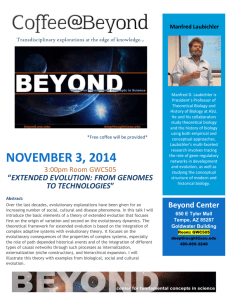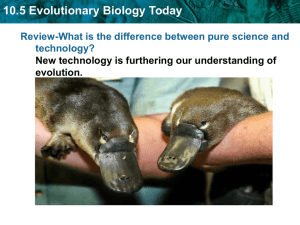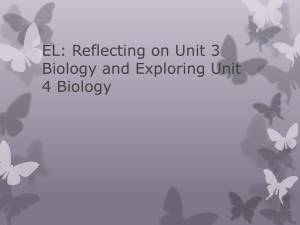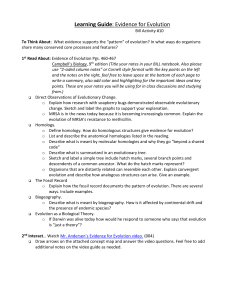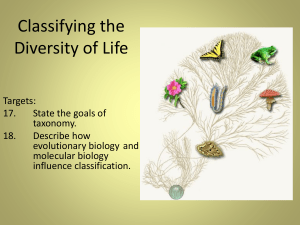Irene Eckstrand and Ida Chow`s Slides ()
advertisement
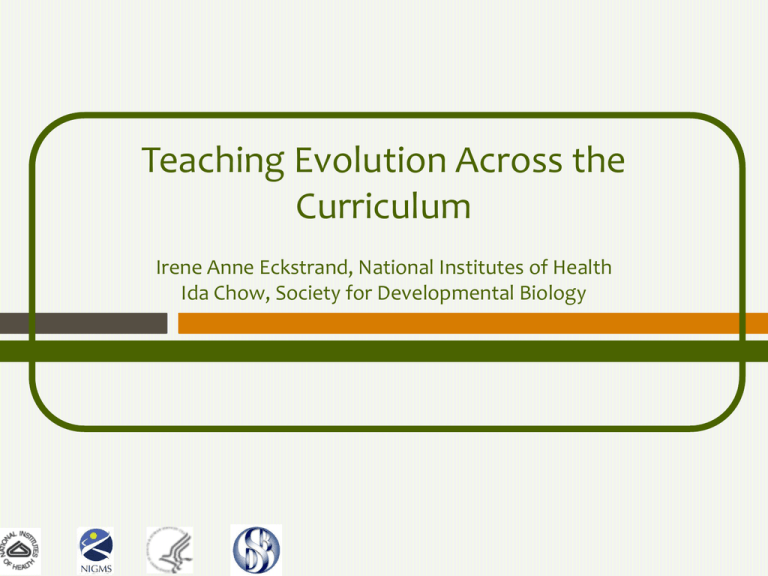
Teaching Evolution Across the Curriculum Irene Anne Eckstrand, National Institutes of Health Ida Chow, Society for Developmental Biology A Short Story… is the fundamental organizing principle of biology Advanced Placement Tests Medical College Admissions Test Big Idea 1: The process of evolution drives the diversity and unity of life. Reorganizing around Foundational Concepts Big Idea 2: Biological systems utilize free energy and molecular building blocks to grow, to reproduce and to maintain dynamic homeostasis. Big Idea 3: Living systems store, retrieve, transmit and respond to information essential to life processes. Big Idea 4: Biological systems interact, and these systems and their interactions possess complex properties. Includes more evolution than in the past (processes that increase genetic diversity) Scientific Foundations for Future Physicians Principle: Demonstrate an understanding of how the organizing principle of evolution by natural selection explains the diversity of life on earth NAS Conference Oct 25-26, 2011 Purpose: Begin to develop a roadmap and strategic plan for engaging professional societies and their members in future work to promote teaching evolution across the biology curriculum. Organizer: Dr. Jay Labov, Senior Advisor for Education and Communication, NAS and NRC Participants: 83 high school and college teachers, scientists, professional society representatives, funders, advocates Agenda: Presentations, working groups, panel discussions, conversation time http://nas-sites.org/thinkingevolutionarily/ NAS Conference Organizing Committee: Cynthia Beall, Case Western Reserve, Chair Paul Beardsley, California State Polytechnic University Ida Chow, Society for Developmental Biology James Collins, Arizona State University Irene Eckstrand, National Institutes of Health Kristin Jenkins, National Evolutionary Synthesis Center Nancy Moran, Yale University Gordon Uno, University of Oklahoma What I Learned… Naïve model Ross Nehm Ohio State University Scientific model Mixed model What I Learned… Teleology Design and purpose analogous to human action are inherent in the rest of nature. Nature is goal-oriented. cause effect What I Learned… Teleonomy Apparent purpose of structures and functions deriving from their evolutionary history cause cause effect What I Learned… Teleonomy They really look more like this – or worse. NIH Curriculum Supplement Students will learn… …the importance of evidence in interpreting examples of evolution and medicine. …how common ancestry relates to the characteristics of living things. …that natural selection is the only evolutionary mechanism to consistently yield adaptations. …why variation among humans is distributed geographically. …that natural selection and common ancestry can explain why humans are susceptible to many diseases. …how to use data and apply principles of natural selection to explain the relatively high frequency of disease in certain populations. …how comparisons of genetic sequences are important for studying evolution. …that the mechanisms of evolution enhance our understanding of health and disease. Coalition of Scientific Societies - Formed in 2006 - Purpose: To respond to the challenges of teaching evolutionary science and related subjects in public schools across the United States. - Initially composed of 17 scientific societies covering all disciplines: physics, chemistry, astronomy, geology, biology, developmental biology, physiology, pathology, pharmacology, genetics, biophysics, social sciences, science teachers. Some 20 additional societies joined the Coalition later. National Academy of Sciences worked with the Coalition. - Surveys: focus groups and telephone surveys on the voting public’s opinion on evolution and teaching of evolution in public school classrooms. Coalition of Scientific Societies Evolution Thought Trail Evolution Thought Trail First USA Science and Engineering Festival Expo in Washington, DC – October, 2010 Coalition Societies at the EVAC American Institute of Biological Sciences American Society for Human Genetics American Society of Plant Biologists Carnegie Institution for Science Ecological Society of America National Academy of Sciences National Association of Biology Teachers National Center for Science Education National Evolutionary Synthesis Center National Museum of Natural History Society for Developmental Biology Society for the Study of Evolution Next Steps Common message on the importance of Thinking Evolutionarily Central resources site /Compilation of existing materials: working group – Susan Musante (AIBS), Jean Heitz (Bio Directors), Ida Chow (SDB), TBD (ABLE). Additional volunteers? Professional development for society members: How to integrate evolution concepts into each disciplinary curriculum. Ex: FASEB evolution resources website; Understanding Evolution website; NCSE website; NESCent website Thinking Evolutionarily Suggestions? Recommendations? Volunteers? Call to Action!
